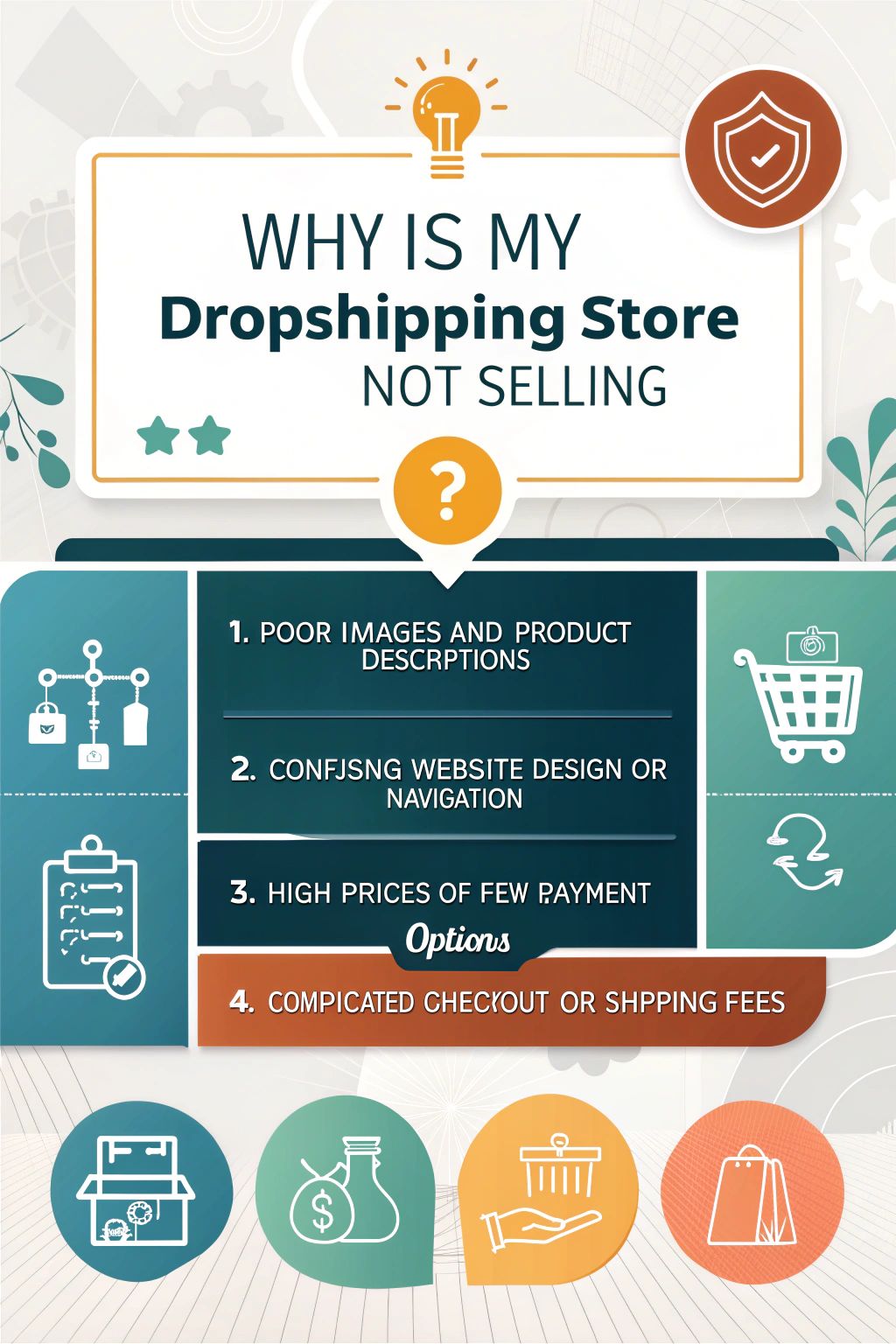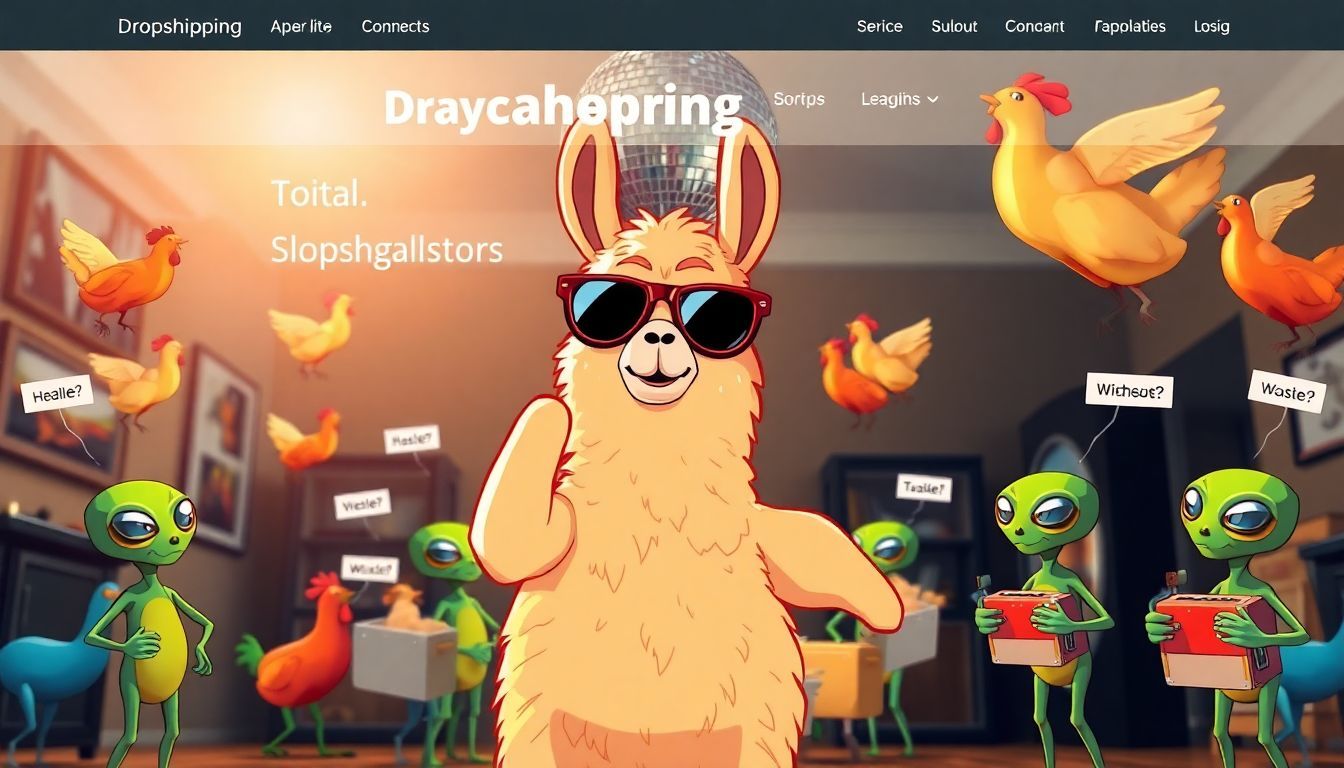Is your dropshipping store struggling to make sales? Many new store owners face this problem. They put in time and effort but see little to no results. It can feel frustrating and confusing when visitors aren’t buying.
Often, the issue isn’t just traffic. Small mistakes like bad product choices or a slow website could be stopping buyers. The good news? These problems have fixes. This blog will explain why your store might not be selling and what you can do about it.
Keep reading for simple steps to boost sales!
Key Takeaways
- Poor product choice, bad images, and unclear descriptions hurt sales. Focus on unique items with good photos and clear details.
- Confusing website design or slow mobile pages push buyers away. Fix navigation and optimize for phones to keep shoppers engaged.
- High prices and limited payment options drive customers off. Offer fair pricing, discounts, and more ways to pay internationally.
- Ineffective ads waste money; test multiple products to find winners fast. Use retargeting campaigns to bring back visitors who didn’t buy earlier.
- Complicated checkout processes or high shipping fees cause cart abandonment. Make checkouts easy with low costs and fast delivery times.

Common Issues Impacting Dropshipping Store Sales

Many dropshipping stores struggle with basic problems that hurt sales. These issues often make it hard to attract buyers or keep them interested enough to purchase.
Lack of Targeted Traffic
Dropshipping stores often struggle with low sales due to a lack of targeted traffic. Without specific customers, decreased sales performance is almost guaranteed. Precision advertising helps reach people who actually want the products.
Platforms like Shopify or BigCommerce offer integrations to simplify this process. Tools such as inventory sync and automatic order fulfillment also make marketing efforts smoother.
Fast shipping and fair pricing attract more buyers but only if they see the store first. A diverse product catalog, like SmokeDrop’s smoke products, can appeal to many customer groups—but needs proper targeting for results.
Efficient inventory management combined with clear marketing plans boosts traffic that converts into real sales.
Poor Product Selection or Saturation
Traffic without the right products leads to wasted effort. Inadequate product choice is a common sales killer. Picking items that nobody wants or are too generic can hurt a store’s success.
Selling what everyone else does causes product saturation, leaving little chance for standing out. Oversaturation in the market lowers visibility and makes competition fierce.
Retailers must watch inventory closely and adjust pricing smartly to beat competitors. Offering products with low demand results in sales decline, while overcrowded niches make it hard to grow.
A solid retail strategy focuses on unique items with consistent market appeal instead of copying trends blindly.
Ineffective Product Descriptions
Shoppers lose interest fast. Poor descriptions confuse them or fail to spark curiosity. Weak wording leads to poor sales performance and fewer conversions.
Strong, clear descriptions build customer trust. Highlight key benefits to set accurate expectations and reduce return rates. A good catalog improves the shopping experience and brings in new customers while encouraging repeat purchases.
Unattractive Product Images
Bad product photos can scare buyers away. Dark, blurry, or poorly-lit pictures make items look cheap. This hurts trust and lowers the chance of a sale. Clear, high-quality images show details and colors well.
They help customers picture the product in their lives.
Good images improve a store’s look too. Shoppers are more likely to revisit stores with professional-looking photos. Great visuals build loyalty and bring repeat buyers back. Using eye-catching pictures is key for boosting sales in dropshipping stores!
Website and Store Design Problems
A messy website can push buyers away fast—learn how to fix this and keep them clicking!
Complicated Navigation
Confusing menus and hard-to-find products can hurt sales fast. Customers need easy access to the product catalog for a good online shopping experience. A cluttered design or buried links frustrate users, making them leave without buying anything.
Adding advanced search filters helps shoppers find items quicker. Clear categories and smooth navigation improve customer satisfaction. User feedback often shows what’s confusing or missing on the site.
Simplified layouts lead to more streamlined user interactions, boosting sales and enhancing efficiency all at once.
Missing or Unprofessional Logo
A missing or sloppy logo hurts credibility. It makes the store look amateur and unreliable. Customers may not trust a business that lacks basic professionalism. A clean, professional logo boosts brand recognition and sets the store apart from competitors.
A strong logo also enhances the shopping experience. It shows attention to detail and builds customer trust. This can lead to higher engagement and repeat sales. Without it, customers might leave without buying anything, costing revenue for the dropshipping business.
Lack of Trust Signals and Emblems
Missing trust badges or secure payment icons can scare buyers away. People want to feel safe before sharing credit card details. Without clear indicators like SSL certificates, customers may worry about transaction safety.
No customer reviews or testimonials can make products seem untested. Stores without strong returns policies or credibility signals often appear unprofessional. Confused branding reduces trust even more, hurting sales quickly.
Poor navigation is another problem that frustrates users and leads to high bounce rates—pointing right to poor mobile optimization next!
Poor Mobile Optimization
A clunky mobile store can lose customers fast. Slow load times frustrate users and make them leave before buying. Small buttons or messy layouts make it hard to shop, pushing buyers away.
Poor navigation on phones leads to cart abandonment, harming sales.
A mobile-friendly website boosts traffic and orders. Responsive web design ensures a smooth shopping experience across devices. This keeps customers engaged and improves conversion rates in e-commerce.
A good mobile layout also helps manage inventory and orders better, making dropshipping smoother overall.
Marketing and Advertising Mistakes
Marketing can make or break your store. If ads don’t grab attention or reach the right people, sales will suffer.
Ineffective Ad Campaigns
Poor targeting ruins ad campaigns. Ads fail without reaching the right audience. Many dropshippers miss sales by ignoring advanced search filters that boost product visibility. A lack of clear differentiation in ads lowers customer engagement and interest.
Ignoring customer feedback hurts ad success too. It blocks improvements in both marketing tactics and product choices. Weak platform integration—like with Shopify or WooCommerce—also limits ad reach and impact, costing store owners more potential buyers.
Not Testing Multiple Products
Ineffective ad campaigns often waste money. Testing multiple products can fix this issue and increase sales.
- Stores that don’t test products miss chances to find top sellers. Not every product will attract buyers, so testing is key.
- Trying one product at a time slows learning. Testing several options helps see what customers prefer faster.
- Consumer preferences change often. Testing catches trends early before the market gets too crowded.
- Product testing ensures you meet your target audience’s needs. It shows which items fit their interests or budgets best.
- Running tests boosts marketing effectiveness by focusing ads on proven winners.
- Campaign analysis becomes clearer with more data from multiple tests.
- Market research works better with varied products in different niches and price points.
- Finding a winning product improves your advertising strategy and lowers wasted ad spend.
Testing keeps stores competitive while helping find what sells well quickly!
Failure to Use Scarcity Tactics
Missing scarcity tactics means missing sales chances. Limited availability can push potential buyers to act fast. A small inventory or countdown timer creates urgency, making them buy now rather than later.
For example, showing “only 3 left in stock” grabs attention and drives faster decisions.
Automated order management helps manage this strategy well. It keeps orders flowing smoothly without errors. Proper inventory management is key too. Overstocking kills the feeling of scarcity and lowers demand for products in the dropshipping business.
No Retargeting Campaigns
Skipping retargeting is a huge marketing blunder. Many people visit a store but don’t buy on the first try. They might get distracted or need more time to decide. Without retargeting, those visitors are gone.
Retargeting ads remind them about the product they viewed. This brings back interested buyers and boosts sales. Missing this tactic wastes ad money and loses possible customers.
How to Find Winning Products for Dropshipping
Finding winning dropshipping products takes smart tools and clear choices. Platforms like SmokeDrop offer over 20,000 items, including smoke accessories, functional glass, and storage solutions.
Advanced search filters can help pinpoint high-demand products quickly. This helps store owners add the best-selling items faster for market entry without wasting time.
Automating tasks also boosts efficiency. Tools for order fulfillment, inventory sync, and tracking updates save time and reduce errors. Linking with platforms like Shopify or WooCommerce makes product listing simple.
Feedback from SmokeDrop’s demos allows sellers to fine-tune their catalog for better results. More variety in stores keeps customers interested longer too!
Pricing and Payment Barriers
High prices can scare shoppers away fast. Limited ways to pay might also make people leave without buying.
Overpriced Products
Expensive goods can drive buyers away. Many dropshipping stores fail because of overinflated prices. Shoppers often compare items online, and if your products cost more, they will leave.
Costly products might work for luxury brands but not for most dropshippers.
Price barriers also create financial obstruction. People want value for their money, especially with so many options available. Stores with premium pricing lose sales to cheaper competitors offering similar quality.
Lowering high pricing or running discounts can boost sales fast!
Limited Payment Options
Limited payment options hurt sales. Customers want easy ways to pay. Offering only one or two methods frustrates them. Some prefer credit cards, while others use PayPal or digital wallets.
If the store doesn’t offer these choices, buyers leave.
Payment restrictions also block international customers. Many countries have unique payment systems. Without local options, those customers can’t buy easily. Dropshippers need to remove these roadblocks to boost sales and build trust with shoppers worldwide.
Checkout and Shipping Issues
A messy checkout drives customers away fast. High shipping costs or unclear delivery times can also scare buyers off.
Complicated Checkout Process
A complicated checkout process can push buyers away. Long forms or too many steps frustrate customers. Automated order fulfillment, like SmokeDrop, helps fix this. It makes buying easier and faster.
Features like inventory sync keep stock updated and avoid delays.
Platforms like Shopify integrate tools to simplify checkouts. Clear payment options also reduce issues. Quick order processing ensures smoother sales flow for the customer and seller alike.
High Shipping Fees or Slow Delivery
A messy checkout experience could lose a customer, but high shipping fees or slow delivery can seal that loss. Expensive shipping costs often make buyers abandon their carts. They see the total price rise and change their minds.
Slow delivery frustrates customers, which hurts future sales and customer retention.
Dropshippers need smoother order processing to fix this issue. Tools like SmokeDrop can help by automating order fulfillment and syncing tracking numbers for transparency. Fast and accurate shipping boosts satisfaction, keeping customers happy.
Integrations with platforms like Shopify ensure quicker management of orders too—cutting delays before they start!
No Clear Return Policy
No return policy can scare buyers. They may worry about losing money if the product is bad or doesn’t fit their needs. Clear refund and exchange policies build trust. Customers feel safer knowing they can fix a problem with their order.
Lack of clear steps for returns also frustrates shoppers. If the process seems hard, people may skip buying altogether. Stores should explain how to handle product returns in simple terms.
A poor return process often leads to bad reviews, which hurts future sales.
Steps to Improve Your Dropshipping Store
Make small changes that can lead to big results—simple fixes can boost your sales. Keep reading for tips to get your store back on track!
Conduct a Test Purchase
Place an order from your own store. Test every step to see how smooth the process is. Notice if the checkout works well or if it feels confusing. Check for things like payment issues or slow processing times.
Inspect the product once it arrives. Make sure it matches the description and photos on your site. Try out the shipping speed, packaging, and quality of service from your supplier.
This helps spot weak points before real customers face them.
Optimize Your Landing Pages
Use a variety of products to make landing pages stand out. Tools like SmokeDrop help add more product assortment. This keeps visitors interested and increases sales chances.
Organize items well with advanced search filters. Platforms like Shopify, WooCommerce, and BigCommerce work great for this. Sync inventory in real-time so customers only see what’s available.
Keep pricing updates accurate to avoid confusion or drop-offs during checkout.
Research and Target Your Niche Audience
Strong landing pages can guide traffic, but targeting the right audience keeps sales flowing. Dropshippers must identify their target market clearly. Knowing who buys your products helps in crafting better ads and offers.
Conduct market research to understand your niche audience’s needs and habits. Define your ideal customer based on age, job, interests, or other factors. Use this data to tailor marketing strategies that connect with them.
Customer segmentation also allows more focused advertising efforts—leading to higher conversions.
Add Reviews and Testimonials
Customer testimonials can boost trust. Positive feedback from buyers shows the product works. Product reviews help others decide to buy. Online reviews and user ratings make a store look reliable.
Adding customer opinions builds confidence in new shoppers.
Use star ratings on all products. Share photos or videos of happy customers with their items. Display product ratings clearly on your site. This improves customer satisfaction and encourages more purchases in your dropshipping store.
Conclusion
Fixing a dropshipping store takes effort, but it’s worth it. Start by checking your traffic and the products you sell. Improve your website design to make it easy for shoppers to use.
Fix ad campaigns and test more items to find what works best. Keep your pricing fair and offer simple checkout options with clear shipping info. Small changes can boost sales fast—take action today!
FAQs
1. Why isn’t my dropshipping store getting sales?
Your store might not be selling because of poor product selection, unclear descriptions, or high prices. Also, weak marketing or targeting the wrong audience can hurt your chances.
2. Could bad website design stop people from buying?
Yes! A messy or slow website can scare customers away. Make sure it’s easy to use, loads fast, and looks professional.
3. Is my marketing strategy the problem?
It could be! If you’re not running ads or using social media right, people won’t find your products. Focus on clear messages and targeting buyers who want what you sell.
4. Are shipping times affecting sales?
Long shipping times often make shoppers leave—especially if they’re used to faster delivery options elsewhere (thanks a lot, big retailers!). Be upfront about timelines and offer tracking info to build trust.



